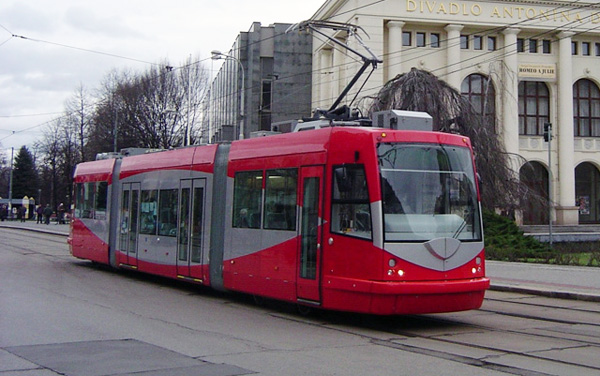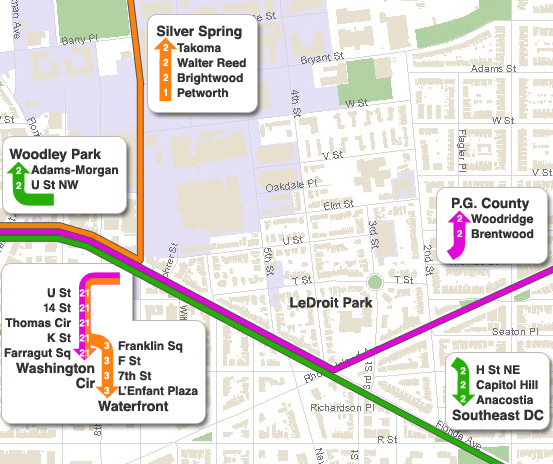Streetcar Open House

The District Department of Transportation (d.) is holding several open houses to display the department’s long-term and short-term plans for expanding transit in the city. These plans, often dubbed DC’s Transit Future, have been on the record since 2002 and a few of the recommendations (the creation of Circulator routes and Metro Extra service) have been in place for some time now.
The most ambitious feature, a network of streetcars, is still in the works. As it stands, the city already owns a set of three streetcars (one is pictured above) and is storing them in Plzeň, Czech Republic, until they can be deployed on the reconstructed H Street in Northeast. The first segment of the reincarnated streetcar system was set to be the short Anacostia streetcar “demonstration” project, but a series of delays and heavy lobbying by Councilmember Tommy Wells (D – Ward 6) have caused Mayor Fenty to reallocate the streetcars to H Street NE (more on the trouble with that below).
Earlier this evening d. released its latest proposal for an eight-line, 37-mile streetcar network to be built in three phases. Three of the proposed routes will border LeDroit Park:
- Orange Route – Georgia Avenue-U St-Downtown-Foggy Bottom-Waterfront: In Phase 1 this section will run along Georgia Avenue from Petworth to Florida Avenue, at which point it will turn west to follow Florida Avenue onto U Street, then south on 14th Street into downtown. At K Street, it will turn west and follow the forthcoming K Street Transitway to Washington Circle in Foggy Bottom. In Phase 3, the train will be rerouted so that it stays on 14th Street all the way downtown, where it will turn east on F Street, then south on 7th Street all the way to the Waterfront on M Street SW. The route will end on 4th Street SW at Fort McNair.
- Purple Route – Rhode Island Avenue-Florida Avenue-U St-Downtown-Foggy Bottom: Phase 2 calls for constructing a line along Rhode Island Avenue in Prince George’s County all the way to Florida Avenue on the edge of LeDroit Park, at which point, the route follows Florida Avenue (a very congested section of roadway) northwest and onto U Street, then south on 14th Street to K Street. At K Street, it will turn west and follow the forthcoming K Street Transitway to Washington Circle in Foggy Bottom.
- Green Route – Woodley Park-Adams-Morgan-U St-Florida Avenue-Capitol Hill-Anacostia-Southeast: Phase 2 also calls for a crosstown route route to pass beside LeDroit Park between Woodley Park and Southeast Washington. The route will start on Calvert Street in Woodley Park, cross the Ellington Bridge into Adams-Morgan, where it will follow 18th Street south to U Street, where it will turn east all the way onto Florida Avenue (at 9th Street). It will follow Florida Avenue all the way to 8th Street NE, on which it will travel south into Capitol Hill to the Navy Yard at M Street SE. It will cross the Anacostia River on the future 11th Street Bridge and follow MLK Avenue through Anacostia and into the far southern reaches of the District.
We have created a map illustrating how the streetcar plan will enhance mobility for LeDroit Park.

Don’t be mistaken; these are just three of eight lines under consideration.
Though we are enthusiastic about the plan, we harbor several concerns about the future direction of this effort.
First, the city must sustain the political will to follow through on these projects. Building a streetcar network requires money and popular support. We have lamented privately that DC’s leadership often ignores transit improvements, but it appears that the projects have the support of Council Chairman Vincent Gray (D – At large) and Councilmember Wells as well as the support of Mayor Fenty and d. director Gabe Klein. However, the fact the Anacostia line is several years late illustrates some of the complexities involved with building a new system.
Second, some jurisdictions have seen the price tags of such improvements and lost their nerve. Some have sought to build cheaper alternatives to streetcars by providing buses that run in their own dedicated bus lanes. This mode, called bus rapid transit, usually requires payment before boarding and has worked well in some cities (e.g. Curitiba, Brazil). The problem is that in America, buses carry a negative image and will have difficulty attracting middle-income riders who would otherwise drive. Additionally, streetcars have higher ridership capacities and are better able to attract development to their routes— no one has ever marketed a property by noting its proximity to a bus stop, after all.
Third, streetcars require overhead catenary wires for power. For the past 120 years Congress has prohibited such wires within the L’Enfant Plan (roughly the area bounded by Florida Avenue, the Potomac, and the Anacostia) and in Georgetown. Unless Congress repeals the ban, streetcars will stop at Florida Avenue or the city will have to invest in some alternative, experimental source of power (e.g. batteries or electromagnetic induction through the street pavement).
Either way, it’s important for residents to ask questions and show their support. The Ward One open house is set for Monday, October 26, 2009, from 7 – 8:30 pm at the Columbia Heights Education Campus, 3101 16th Street, NW (metro: Columbia Heights). d. is hosting open houses throughout the city through November 4.







Recent Comments